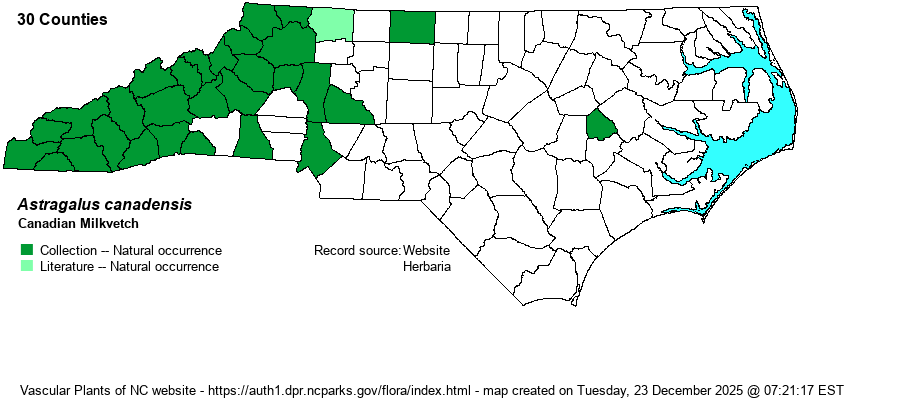| Author | L. | |
| Distribution | Throughout the Mountains; scattered over most of the Piedmont foothills, but local eastward to Rockingham, Rowan, and Mecklenburg counties. A specimen from Greene County, in the central Coastal Plain, is remarkably disjunct: "near Bat Alley, Walstonburg" in 1956.
This is a very widespread species across most of southern Canada and the U.S., but in the East mainly in the Mountains; ranges southeast to central NC and northwestern SC, but absent over nearly all of GA. | |
| Abundance | Formerly fairly common to frequent in the Mountains, but seemingly has declined markedly, and is now infrequent in most areas. Rare to uncommon in the foothills, and very rare in the central Piedmont. | |
| Habitat | This is a species of rich and mostly moist soils, typically in circumneutral soils and usually in partly open settings. It is most often seen along margins of Rich Cove Forests, such as along wooded roadbanks and other edges, openings along wooded stream banks, and openings in bottomlands and rich woods. | |
| Phenology | Blooms from June into August, and fruits from July to October. | |
| Identification | This is a fairly robust herb, growing often to 3-4 feet tall, though it is not really "leafy" nor bushy like some other tall legumes. It has only scattered (widely separated), alternate leaves that are pinnately divided into 13-29 narrow leaflets. The leaflets are about 3/4-1-inch long. The flower cluster (raceme) grows on very long stalks about 4-5 inches long, from leaf axils and the stem terminus. The cluster is about 3-4 inches long, composed of numerous pale yellow to cream-yellow flowers, each about 2/3-inch long; the cluster grows strongly erect. The fruit (pods) are numerous but are insignificant for identification, as generally no other plant in the mountains and foothills is really similar in structure and flower cluster. This plant might be most likely seen as you are driving along a road through a moist forest, such as along a US Forest Service road, and catching the light yellow flower cluster in summer on the roadbank. Because of its fairly tall stature, when in bloom this is a quite striking species, worth the time to study and photograph it. | |
| Taxonomic Comments | Many references, not surprising owing to its very large range, list several taxa within the full species. Weakley (2018) lists the nominate form -- Astragalus canadensis var. canadensis -- as the variety found in the state.
| |
| Other Common Name(s) | Canada Milkvetch | |
| State Rank | S3? [S3S4] | |
| Global Rank | G5 | |
| State Status | | |
| US Status | | |
| USACE-agcp | FAC link |
| USACE-emp | FAC link |

